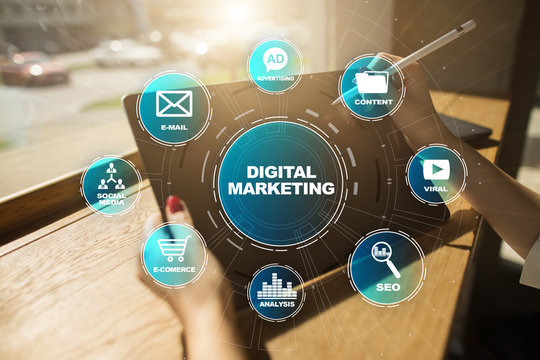Digital marketing effectively began in 1990 when the Archie Search Engine was created as an index for FTP sites. In the 1980s, the storage capacity of computers was already large enough to store huge volumes of customer information. Companies started choosing online techniques, such as database marketing, rather than limited list brokers. Database allowed companies to track customers’ information more effectively, transforming the relationship between buyer and seller.
Digital Media growth was estimated at 4.5 trillion online ads served annually with digital media spending at 48% growth in 2010. An increasing portion of advertising stems from businesses employing Online Behavioural Advertising (OBA) to tailor advertising for internet users, but OBA raises concerns about consumer privacy and data protection.

# Marketing
# Digital Marketing
#SEO
#SMO

# Digital Marketing
#Email Marketing
#SEO
Digital marketing became more sophisticated in the 2000s and the 2010s, when the proliferation of devices capable of accessing digital media led to sudden growth. Statistics produced in 2012 and 2013 showed that digital marketing was still growing With the development of social media in the 2000s, such as LinkedIn, Facebook, YouTube, and Twitter, consumers became highly dependent on digital electronics, in their daily lives. Therefore, they expected a seamless user experience across different channels for searching product information. The change in customer behaviour improved the diversification of marketing technology.
The term “Digital Marketing” was coined in the 1990s. Digital marketing marketing known as and referred to as ‘online marketing ‘online marketing’, or ‘web marketing’. Worldwide digital marketing has become the most commonly used term and has taken off in the business industry, especially after the year 2013. However in other countries like Italy, digital marketing is still known as web marketing.
Online methods used to build brand awareness
Digital marketing strategies may include the use of one or more online channels and techniques (omnichannel) to increase brand awareness among consumers. Building brand awareness may involve such methods/tools as:
Search engine optimization (SEO)
Search engine optimization techniques may be used to improve the visibility of business websites and brand-related content for common industry-related search queries. The importance of SEO to increase brand awareness is said to correlate with the growing influence of search results and search features like featured snippets, knowledge panels, and local SEO on customer behavior.
Search engine marketing (SEM)
SEM, also known as PPC advertising, involves the purchase of ad space in prominent, visible positions atop search results pages and websites. Search ads have been shown to have a positive impact on brand recognition, awareness and conversions.
33% of searchers who click on paid ads do so because they directly respond to their particular search query.
Social media marketing
Social media marketing has the characteristics of being in the marketing state and interacting with consumers all the time, emphasizing content and interaction skills. The marketing process needs to be monitored, analyzed, summarized and managed in real-time, and the marketing target needs to be adjusted according to the real-time feedback from the market and consumers. 70% of marketers list increasing brand awareness as their number one goal for marketing on social media platforms. Facebook, Instagram, Twitter, and You tube are listed as the top platforms currently used by social media marketing teams. As of 2021, LinkedIn has been added as one of the most-used social media platforms by business leaders for its professional networking capabilities.
Content marketing
56% of marketers believe personalization content – brand-centered blogs, articles, social updates, videos, landing pages – improves brand recall and engagement.
Benefits of digital marketing
Possible benefits of digital marketing include:
- any information that is needed is accessible at any time and/or place
- surpasses internet marketing and also possesses alternatives choices without the internet needed
- top in presenting beneficial ways and features that reach, inform, engage, offer, and sell services and products to consumers
- businesses can attain data that present target audiences based on their age, location, interests, and education
- low investment, the cost per lead is 61% less expensive than traditional marketing
- able to reach every mobile user, there are over 14 billion worldwide mobile devices and with a projection to grow to almost 18 billion by the year 2024
Sharing economy
The “sharing economy” refers to an economic pattern that aims to obtain a resource that is not fully used. Nowadays, the sharing economy has had an unimagined effect on many traditional elements including labor, industry, and distribution system.[104] This effect is not negligible that some industries are obviously under threat. The sharing economy is influencing the traditional marketing channels by changing the nature of some specific concept including ownership, assets, and recruitment.
Digital marketing channels and traditional marketing channels are similar in function that the value of the product or service is passed from the original producer to the end user by a kind of supply chain. Digital Marketing channels, however, consist of internet systems that create, promote, and deliver products or services from producer to consumer through digital networks. Increasing changes to marketing channels has been a significant contributor to the expansion and growth of the sharing economy. Such changes to marketing channels has prompted unprecedented and historic growth.] In addition to this typical approach, the built-in control, efficiency and low cost of digital marketing channels is an essential features in the application of sharing economy.
Digital marketing channels within the sharing economy are typically divided into three domains including, e-mail, social media, and search engine marketing or SEM.
- E-mail- a form of direct marketing characterized as being informative, promotional, and often a means of customer relationship management. Organization can update the activity or promotion information to the user by subscribing the newsletter mail that happened in consuming. Success is reliant upon a company’s ability to access contact information from its past, present, and future clientele.
- Social Media- Social media has the capability to reach a larger audience in a shorter time frame than traditional marketing channels. This makes social media a powerful tool for consumer engagement and the dissemination of information.
- Search Engine Marketing or SEM- Requires more specialized knowledge of the technology embedded in online platforms. This marketing strategy requires long-term commitment and dedication to the ongoing improvement of a company’s digital presence.
Other emerging digital marketing channels, particularly branded mobile apps, have excelled in the sharing economy. Branded mobile apps are created specifically to initiate engagement between customers and the company. This engagement is typically facilitated through entertainment, information, or market transaction.

